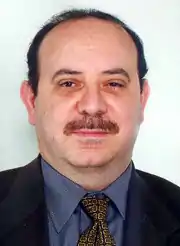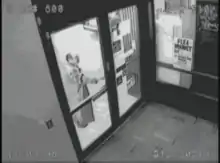John Ruffo
John Ruffo (born November 24, 1954) is an American former business executive, white-collar criminal and confidence man, who in 1998 was convicted in a scheme to defraud many US and foreign banking institutions of over 350 million dollars. The swindle is considered one of the most significant cases of bank fraud in US history.[1] He has been a fugitive from justice ever since, and is on the U.S. Marshals 15 Most Wanted Fugitives list.[2]
John Ruffo | |
|---|---|
 | |
| Born | November 24, 1954 |
| Disappeared | November 9, 1998 (aged 43) JFK Airport, New York City |
| Status | Missing for 22 years, 2 months and 23 days |
| Nationality | American |
| Other names |
|
| Occupation | Former business executive |
| Employer | Consolidated Computer Services (CCS) |
| Known for | Wanted by the United States Marshals Service for bank fraud |
| Height | 5 ft 6 in (1.68 m) |
| Criminal status | at-large |
| Allegiance |
|
| Criminal charge | |
| Penalty | 17 years in prison |
Reward amount | $25,000 |
Capture status | fugitive |
Wanted by | United States Marshals Service |
| Wanted since | November 1998 |
Time at large | 22 years, 2 months and 23 days |
| Comments | currently on the U.S. Marshals 15 Most Wanted Fugitives list |
He was the President of CCS, an IBM equipment reseller in New York City, in 1996.[3][4][5]
Early life and education
Ruffo was born to a close-knit Italian American family in a working class neighborhood in Brooklyn. He attended New York University on a scholarship, earning a degree in computer science. In May 1980, he married his childhood sweetheart, Linda. Ruffo initially worked for United Computer Systems LLC in New York, before eventually branching out to form his own firm, Consolidated Computer Services (CCS).[6]
Criminal activity, arrest and conviction
Ruffo became acquainted with and befriended another prominent New York businessman, Edward J. Reiners, formerly an executive with Philip Morris USA. After Reiners was laid off, he approached Ruffo with an idea in 1992. The scheme involved soliciting various banks in an attempt to secure financing for a fictitious "Project Star". They pitched the project to bank executives as a top secret operation for Phillip Morris to develop smokeless cigarettes. Ruffo's company, CCS, was to provide the computer hardware and consulting for five offices set up to work on the project. They leveraged Reiners' prior credentials as a Phillip Morris executive to forge documents and add authenticity to the scheme. They also included stringent confidentiality agreements stipulating that because of the sensitivity of the project, banks were to deal only with Reiners and to never contact Phillip Morris directly.[7]
Ruffo tried to avoid suspicion by making timely interest payments on the loans. However, in 1996 a bank executive at the Long-Term Credit Bank of Japan noticed an irregularity on one of the forged documents. After he contacted Phillip Morris and then the FBI, the scheme began to unravel. Reiners was arrested by FBI agents who set up a sting operation on March 19, 1996, and an arrest warrant was issued for Ruffo two weeks later. All told the scheme generated over $350 million in secured loans, though much of it was squandered in poor stock market speculation and exorbitant spending habits on the part of the conspirators. $21 million, however, was never accounted for by federal authorities.[5]
Ruffo faced a 150-count indictment charging him with bank fraud, money laundering, wire fraud, and conspiracy. His bail was set at an unusually high $10 million as he was considered a flight risk. As nearly all of Ruffo's known assets and accounts were frozen by the FBI, most of his immediate family put up their homes as collateral to secure his pre-trial release. Ruffo was found guilty on all counts and was sentenced to 17 years in prison.[8][9]
Fugitive


In November 1998, Ruffo failed to turn himself over to the U.S. Marshals Service to begin serving his sentence. His image was captured on CCTV cameras taking money out of an ATM (pictured) on the afternoon he was to report, but he has not been seen nor heard from since. In his wife's last communication with him on the morning of his disappearance, he told her he was meeting with a parole officer but never returned. His car was later recovered by the FBI abandoned at JFK Airport. Three months after Ruffo's disappearance, the homes of his wife, mother, mother-in-law, and others were seized by the government as a forfeiture of bond collateral, effectively making them all homeless.[10]
In April 2001, Ruffo was sighted in Duncan, Oklahoma, he visited several community banks attempting to open an account so he could receive $250 million of wire transfers from Nigeria. [11]
Authorities believe Ruffo still has access to substantial overseas financial resources, which could be aiding him in his ability to stay off-the-grid and assume a new identity. Chief Deputy US Marshall John Bolen commented in 2013, "Having been sentenced to 220 months of incarceration and not serving a single day of that kind of sticks in the craw of those of us in this profession. His actions are a mockery to our justice system. We are the best in the world at this. He just has to make one mistake. We can make many but he just has to make one. We'll catch him". Ruffo's last attorney, Jeffery Lichtman, offered the following when asked if he thought authorities would ever capture his former client: "I think if I had to be a betting man, I'd put my money on John Ruffo. Because from what I can see so far, he is smarter than the people looking for him."[12][13]
Ruffo remains at large. The U.S. Marshals Service is offering a $25,000 reward for information that leads to the capture of John Ruffo.[1][14][15]
See also
- Financial crimes
- List of fugitives from justice who disappeared
- Taylor, Bean & Whitaker, former top tier mortgage firm who ceased all operations in 2009 due to bank fraud and financial crimes.
- U.S. Marshals 15 Most Wanted Fugitives
References
- "WANTED - John Ruffo". usmarshals.gov.
- "Money To Run, But No Skills To Hide". NPR.org. 25 May 2009. Retrieved 29 August 2015.
- Kenneth N. Gilpin (June 6, 1996). "Ex-Employee of Philip Morris Pleads Guilty to Bank Fraud". The New York Times. Retrieved August 28, 2015.
- Bill Atkinson and Gary Cohn (April 22, 1996). "$323.5 million bank fraud's unraveling cuts a wide swath Story unfolds: Despite the millions involved, the loan scheme was relatively simple and its victims went along easily". Baltimore Sun. Retrieved August 28, 2015.
Of that, about $180 million was invested in stocks controlled by Mr. Reiners and John Ruffo, president of CCS Inc., according to court documents, sources and Judd Burstein, Mr. Ruffo's attorney.
- "New York Executive Is Indicted In Connection With Loan Scam". Wall Street Journal. March 7, 1997. Retrieved August 29, 2015.
- "Signed, Sealed and Stolen". CNBC. Docs. Retrieved 29 August 2015.
- "Ex-Employee of Philip Morris Pleads Guilty to Bank Fraud". The New York Times. Retrieved 29 August 2015.
- "Male, rich and smart? You're a scammer's dream". Yahoo News. Retrieved 29 August 2015.
- "Judgement in a Criminal Case (USA vs. Ruffo)". CNBC. Federal District Court. Retrieved 29 August 2015.
- "John Ruffo, elusive NYC swindler, still on the run after 20 years". NBC News. Retrieved 2019-09-17.
- "Scam Artist Said Sighted In Oklahoma". American Banker. Retrieved 25 April 2001.
- Minutes, 60 (2007-11-01). Con Men: Fascinating Profiles of Swindlers and Rogues from the Files of the Most Successful Broadcast in Television History. Simon and Schuster. ISBN 9781416593195.CS1 maint: numeric names: authors list (link)
- "John Ruffo, elusive NYC swindler, still on the run after 20 years". NBC News. Retrieved 2019-09-17.
- "Signed, Sealed, and Stolen". CNBC. CNBC. Retrieved 29 August 2015.
- "Money to Run, But No Skills to Hide". NPR. Retrieved 29 August 2015.
External links
- John Ruffo at the US Marshals Service